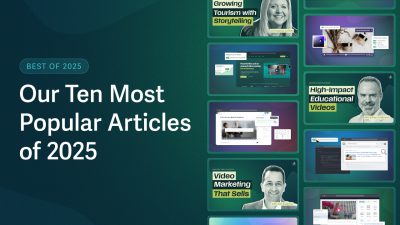Live streams are one of the most powerful tools you can use to reach your audience. But how do you fit them in as a recurring part of your video marketing plan?
In this post, we’re going to be breaking down exactly how to make live streams a regular part of your video marketing plan. By the end of this post, you’ll have a greater understanding of the planning process necessary to pull this off. We also include a rundown at the end of how we started live streaming using this exact process.
Why You Should Incorporate Live Streaming
It should come as no surprise that live streaming is the next big thing as far as video marketing is concerned. We even listed it as one of our top video marketing trends for 2021. While it’s been around for quite some time, it’s really hitting its stride as the go-to medium for connecting with your audience.
Live video is one of the best ways to connect with your audience outside of being in the same room with them. Being able to engage with your audience live is invaluable in today’s crowded social space. You can create really unique and vibrant experiences that can be beneficial to your audience and business alike.
The numbers back up these claims as well. For example, only 35% of marketers use live video which means it’s a great way way to stand out from the crowd. Additionally, 82% of viewers prefer to see a live stream rather than a social post, meaning this is a very untapped market. Read more about the statistics behind live streaming in this piece from Influencer Marketing Hub.
1.What Is Your Goal With Live Streaming?
The first question you’ll need to ask yourself is, “why do I want to start live streaming on a regular basis?” What objectives do you want to achieve and how will it help the business? Brand awareness, lead generation, education, new revenue sources, or event coverage are all amazing ways to make live streaming a valuable asset for your business. Once you have an idea for what you’re after, that will help inform some of the decisions you’ll have to make moving forward.
2. Deciding On The Content Direction
In theory, you could totally wing it, pull out your phone and go live on the company Instagram right now and just start chatting to whoever shows up. We wouldn’t recommend this. Planning out the type of content you want to deliver to your audience is going to be just as important as the content itself.
Depending on your goals and the type of company you have, a number of different options may work. Live tutorials or product demos, interviews, behind-the-scenes, or Q&A sessions are all great avenues to start off with.
While you’re in the planning process, there are some important questions to keep in mind when deciding which direction to go in.
- Who is our target audience and will this resonate with them?
- How often can I produce this type of content?
- What’s the lead time for pre-production?
- Who will be on camera?
- Does the content rely on getting guest speakers, and if so, how much lead time will we need to book them?
- Will this direction raise awareness for the brand?
- Will these videos be able to be repurposed in the future?
Like any new venture, this will take some time to hammer out the details. Don’t be afraid to test out different formats, ideas, and strategies.
Last year, we saw a lot of innovative ways businesses were using live video. Shoppable product demos, live conferences, virtual parties, and behind-the-scenes content really stood out to us. Read this post to see in-depth examples.
3. Choosing The Right Platform
When it comes to choosing where to host your live stream, it will mainly come down to deciding between streaming to social media platforms like Facebook or a professional service like SproutVideo. Both options have their place, but depending on what you’re trying to achieve, one may make more sense for your marketing plan than the other.
Social Media Live
If you’re trying to reach a broad audience, social is going to be the way to go. It seems like just about every social platform has a live streaming feature at this point.
If you have a sizable following on these platforms, it makes sense to address your viewers where they are. However, social live streaming lacks a few important factors. You’ll have limited control over the look and feel of your stream on the platform, there may be ads before, during, or after your stream, and analytics might be limited depending on the platform.
Professional Live Streaming
Streaming with a professional video hosting service alleviates these pain points and more. You’ll have more control over branding, in-depth analytics, privacy settings, video marketing tools, and more.
You won’t have a built-in audience like on social media, but that can be fixed with proper promotion, which we’ll cover below. Additionally, some software allows you to multi-cast your live stream and broadcast it to your social media channels, creating a best of both worlds situation. Watch our recorded live stream to learn more about all the features you’ll have access to using a professional video hosting service.
4. The Equipment You’ll Need
One important detail you’ll have to consider is the extra equipment you’ll need to execute a professional live stream. This would include a professional camera setup (if you don’t already have one), HDMI cables, a video capture device, and encoding software.
Streaming with your phone is a good place to start, but this equipment will take your production value to a whole new level. For a full rundown of the components needed for a live stream, check out our post “Six Simple Steps to Live Streaming for Business.”
5. Adding Live Stream Promotion
In addition to adding live streaming to your video marketing plan, you’ll have to add elements that promote it as well. Without an audience, all the planning and preparation you would have done would have been for nothing.
Creating a teaser video and social media graphics is a great way to deliver important information about your stream. Be sure to tap both your email list and social media. This will make sure that everyone receives information about your live streams regardless of where they follow you on the internet.
Promoting 2-3 weeks before the event will give you plenty of time to get the word out. Be sure to include easy ways for people to set reminders for when the event is happening. Having a landing page with more information and registration forms is one of the best ways to accomplish this. You can create an email workflow to send reminders about the event leading up to it plus this lets you capture emails from your audience. A win-win.
6. Reviewing Performance
Like with all new initiatives, it’s important to take a step back to review how your live streams performed. Taking a look at your analytics will be key to understanding how engaged your audience was, where people dropped off, and inform how you can improve in the future.
When using a platform like ours, you’ll have access to analytics during the broadcast and after it’s ended. It will give you the most well-rounded view of how well your video performed. To learn more about the live stream metrics that matter, explore our full post on the topic.
Example: SproutVideo Cheers Series
We recently began the journey of incorporating live streaming into our own marketing plan, after adding it as a feature to our platform last year. Below we’ll go through our process to demonstrate how you can apply the tips above for your live stream planning.
We wanted to start live streaming for a few reasons. We wanted to illustrate the power of our platform, create brand awareness, educate and entertain our audience, and capture leads. After some deliberation, we came up with the idea for our “Cheers Series.” In this live stream series, we raise our glasses to important people and topics related to the video industry. We do this through conversations between our staff and interviews with experts in their field.
We acquired the necessary equipment for those who would be on camera and created a cadence that gives us enough runway to plan, secure guest speakers, and promote the event without losing our minds.
As mentioned, we host these events entirely through the SproutVideo platform. We customized the event landing pages, and also leverage chat features and marketing tools to engage our audience. When the events conclude, we also analyze performance to make sure our message is resonating with viewer engagement reports.
We’re hosting our third episode on April 21st, featuring Emma Stones from the Garden Museum in London, and have plans to continue this series far into the future. We’ll continue monitoring and experimenting with our plans to keep improving our series as time goes on.
Live streaming is here to stay and there’s no better time to add it to your strategy than right now. Adding a new element to your marketing mix is never an easy task. New ventures take time to set up, gain traction, and show results. Be patient and consistent and the results will come. Let us know what type of content you’ll be live streaming in the comments below.








